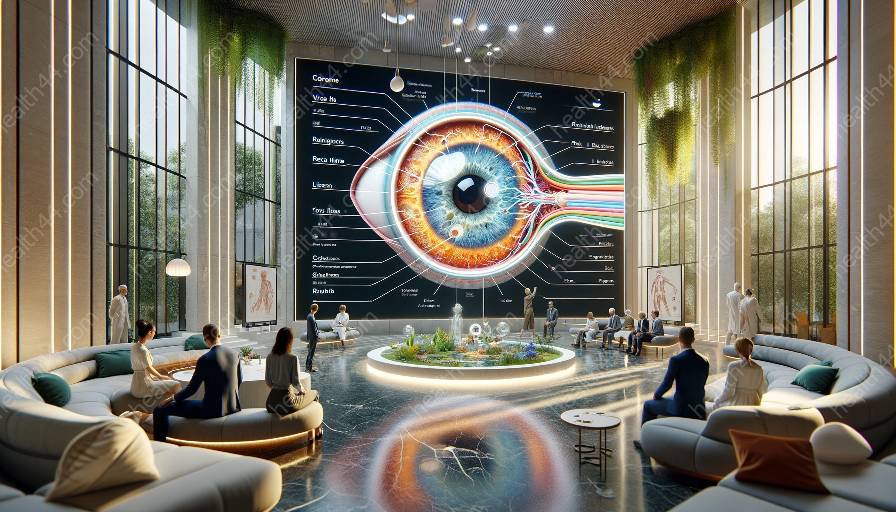As we age, the structure and function of our eyes undergo various changes that can impact vision. These changes can affect multiple parts of the eye, including the lens, retina, and other crucial components. In this comprehensive guide, we will delve into the intricate details of how aging affects the eye, explore the anatomy of the eye, and discuss vision rehabilitation strategies to maintain optimal eye health.
The Anatomy of the Eye
Before delving into the effects of aging on the eye, it is essential to have a thorough understanding of the eye anatomy. The eye is a complex organ composed of several interconnected structures that work together to facilitate vision. These structures include the cornea, iris, lens, retina, and optic nerve, among others.
The cornea is the transparent, dome-shaped front surface of the eye, responsible for refracting light and focusing it on the retina. The iris, located behind the cornea, regulates the amount of light entering the eye by adjusting the size of the pupil. The lens, situated behind the iris, further focuses light onto the retina.
The retina, located at the back of the eye, consists of specialized cells that convert light into electrical signals, which are then transmitted to the brain via the optic nerve. Understanding the intricate anatomy of the eye provides valuable insights into how aging may impact its structure and function.
Effects of Aging on the Eye Structure and Function
Aging can lead to various structural and functional changes within the eye, ultimately affecting vision. One of the most notable changes is the hardening and stiffening of the eye's lens. This process, known as presbyopia, occurs with age and can result in difficulties focusing on nearby objects. As the lens loses its flexibility, individuals may require reading glasses or bifocals to compensate for this change.
Moreover, the retina may undergo aging-related changes, such as the degeneration of macular cells, leading to age-related macular degeneration (AMD). This condition can result in central vision loss, making tasks such as reading and recognizing faces challenging. Similarly, the optic nerve may also be affected by aging, potentially leading to conditions such as glaucoma, characterized by increased intraocular pressure and damage to the optic nerve.
Changes in the vitreous, the gel-like substance that fills the space between the lens and the retina, can also occur with age. The vitreous may become more liquefied, leading to the development of floaters or the detachment of the retina. Additionally, the muscles that control the eye movements may weaken over time, impacting overall eye coordination and alignment.
These age-related changes in the eye's structure and function underscore the importance of proactive eye care and regular vision assessments, particularly as individuals age.
Vision Rehabilitation and Aging
Despite the natural aging processes that affect the eye, various vision rehabilitation strategies can help individuals maintain and enhance their visual capabilities. Vision rehabilitation encompasses a range of interventions aimed at optimizing visual function, enhancing independence, and improving quality of life for individuals with visual impairments.
One key aspect of vision rehabilitation for the aging population involves the use of assistive devices and technologies. These may include magnifiers, telescopic lenses, and electronic magnification systems, which can aid individuals with reduced acuity and contrast sensitivity. Additionally, specialized lighting systems and glare-reducing filters can help minimize visual disturbances and improve comfort during reading and other activities.
Furthermore, vision rehabilitation professionals offer personalized training in activities of daily living, such as reading, cooking, and navigating the environment. By providing adaptive strategies and techniques, these professionals empower individuals to overcome visual challenges and maintain their independence.
Another crucial component of vision rehabilitation is the implementation of low vision aids and devices. These may include handheld or stand magnifiers, video magnifiers, and specialized optical systems designed to enhance the remaining vision and facilitate tasks that require close-up or distance vision.
Beyond the use of assistive devices, vision rehabilitation often encompasses educational support and counseling to address the emotional and psychological impact of vision loss. Providing individuals with coping strategies and fostering a supportive environment can significantly improve their overall well-being and adjustment to age-related visual changes.
Conclusion
As individuals age, the structure and function of the eyes undergo significant changes that can impact visual acuity and overall eye health. Understanding these age-related changes and their implications is crucial for implementing proactive eye care measures and seeking appropriate vision rehabilitation interventions. By staying informed about the impact of aging on the eye, individuals can take proactive steps to maintain optimal eye health and enhance their visual well-being for years to come.





















